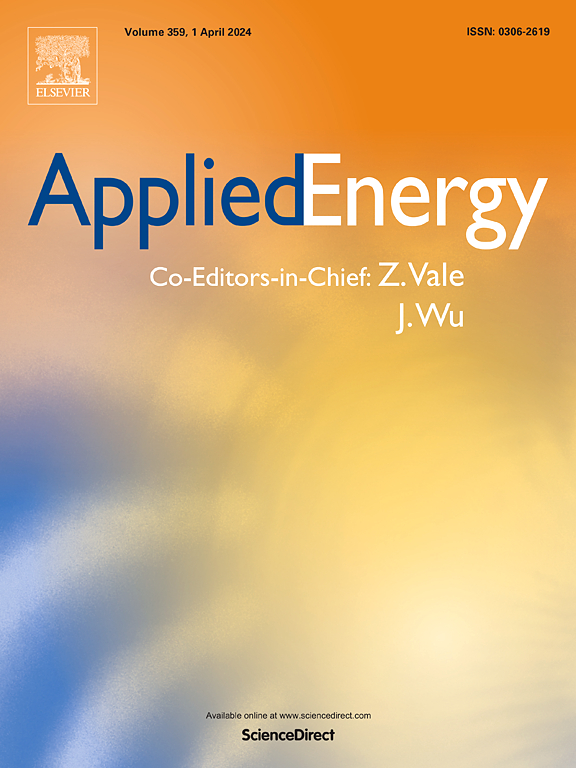受经典数学函数启发的新型非线性流道对热再生氨基液流电池输出性能和低品位热回收效率的影响
IF 10.1
1区 工程技术
Q1 ENERGY & FUELS
引用次数: 0
摘要
针对提高热再生氨基液流电池(TRAFB)的输出性能和低品位废热回收效率的挑战,本研究引入了四种新的非线性流道:双曲正切函数流道(HTF-FC)、椭圆函数流道(EF-FC)、二次函数流道(QF-FC)和指数函数流道(ExF-FC)。这些流道设计受到经典数学函数曲线的启发,能够基于物种分布更有针对性地增强传质。在正向流动模式(FF模式)和反向流动模式(RF模式)下,采用多个定量指标评估了这些非线性结构对跨尺度传质、反应物分布、功率输出和热电转换效率的影响。研究结果表明,优化通道端电极界面的传质是提高TRAFB性能的关键。非线性流动通道在FF模式下的整体性能优于RF模式,但两者都优于传统的直线通道(S-FC),其中ExF-FC表现出最好的性能,HTF-FC表现最差。ExF-FC在电极区域表现出最高的整体传质效率和活性物质的均匀性,其在通道尾部的非线性收缩区引起了显著的加速效应,使反应物缺乏区域的Cu2+通量增加了约39.13倍。当进口流量为1 mL/min时,HTF-FC、QF-FC、EF-FC和ExF-FC与S-FC相比,峰值功率密度分别提高了~ 1.30%、~ 11.52%、~ 54.67%和~ 80.65%,当进口流量增加到3.8 mL/min时,峰值功率密度分别提高了~ 1.62%、~ 42.60%、~ 101.38%和~ 142.84%。此外,非线性通道显著提高了TRAFB的储能能力和余热回收性能,特别是在高电流密度下。当电流密度为350 A/m2,进口流量为1 mL/min时,ExF-FC的电容量和热电转换效率分别比S-FC提高了~ 2.81倍和~ 5.41倍,进口流量为3.8 mL/min时,分别提高了~ 1.11倍和~ 2.98倍。本文章由计算机程序翻译,如有差异,请以英文原文为准。
Effects of novel nonlinear flow channels inspired by classical mathematical function on the output performance and low-grade heat recovery efficiency of thermally regenerative ammonia-based flow battery
In addressing the challenges of enhancing the output performance and low-grade waste heat recovery efficiency of thermally regenerative ammonia-based flow battery (TRAFB), this study introduces four novel nonlinear flow channels: the Hyperbolic tangent function flow channel (HTF-FC), Elliptic function flow channel (EF-FC) Quadratic function flow channel (QF-FC), and Exponential function flow channel (ExF-FC). These flow channel designs are inspired by classical mathematical function curves, enabling more targeted mass transfer enhancement based on species distribution. Multiple quantitative metrics are employed to evaluate the effects of these nonlinear structures on cross-scale mass transfer, reactant distribution, power output, and thermoelectric conversion efficiency under both Forward Flow mode (FF mode) and Reverse Flow mode (RF mode). The findings reveal that optimizing mass transfer at the electrode interface of the channel end is more critical for enhancing performance in TRAFB. The overall performance of the nonlinear flow channels in FF mode is superior to that in RF mode, yet both outperform the conventional straight channel (S-FC), with the ExF-FC showing the best performance and the HTF-FC the least. The ExF-FC exhibits the highest overall mass transfer efficiency and uniformity of active species in the electrode region, and its nonlinear contraction zone at the channel tail induces a significant acceleration effect, increasing the Cu2+ flux by ∼39.13 times in the reactant-starved region. When the inlet flow rate is 1 mL/min, the HTF-FC, QF-FC, EF-FC, and ExF-FC can enhance the peak power density by up to ∼1.30 %, ∼11.52 %, ∼54.67 %, and ∼ 80.65 %, respectively, compared to the S-FC, and when the inlet flow rate is increased to 3.8 mL/min, these enhancements reach ∼1.62 %, ∼42.60 %, ∼101.38 %, and ∼ 142.84 %, respectively. Moreover, the nonlinear channels significantly improve the energy storage capacity and waste heat recovery performance of TRAFB, particularly at high current densities. When the current density is 350 A/m2, at an inlet flow rate of 1 mL/min, the ExF-FC can enhance the electrical capacity and thermoelectric conversion efficiency by ∼2.81 times and ∼ 5.41 times, respectively, compared to the S-FC, and at an inlet flow rate of 3.8 mL/min, these increases are ∼1.11 times and ∼ 2.98 times, respectively.
求助全文
通过发布文献求助,成功后即可免费获取论文全文。
去求助
来源期刊

Applied Energy
工程技术-工程:化工
CiteScore
21.20
自引率
10.70%
发文量
1830
审稿时长
41 days
期刊介绍:
Applied Energy serves as a platform for sharing innovations, research, development, and demonstrations in energy conversion, conservation, and sustainable energy systems. The journal covers topics such as optimal energy resource use, environmental pollutant mitigation, and energy process analysis. It welcomes original papers, review articles, technical notes, and letters to the editor. Authors are encouraged to submit manuscripts that bridge the gap between research, development, and implementation. The journal addresses a wide spectrum of topics, including fossil and renewable energy technologies, energy economics, and environmental impacts. Applied Energy also explores modeling and forecasting, conservation strategies, and the social and economic implications of energy policies, including climate change mitigation. It is complemented by the open-access journal Advances in Applied Energy.
 求助内容:
求助内容: 应助结果提醒方式:
应助结果提醒方式:


